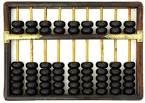COMPUTING DEVICE (PRE – COMPUTER AGE TO 19TH CENTURY)
(i)
ABACUS: This is the first calculating device invented
by Chinese. It is made up of a frame divided into two parts by a horizontal bar
an vertical threads. It is also known Soroban in Japan and Suan Pan in China.
It is used for adding and subtracting numbers.
(ii)
JOHN NAPIER BONE: In 1917, Scotsman named John Napier
invented logarithm which are a technology that allows multiplication. It
consists of a set of eleven rods, with four sides each used as a multiplication
tool. These rods were made with bones.
(iii)
SLIDE RULE: Napier’s invention led directly to slide
rule. It was first built in England in 1632. It uses two logarithm scales to
allow rapid multiplication and division of numbers.
(iv)
PASCAL’S CALCULATOR: In 1642, Blaise Pascal, a French
mathematician and scientist at age 19 invented the PASCALINE which is the first
mechanical calculating machine. It is used for addition and subtraction of up
to 8 digits number.
(i)
LEIBNITZ’S CALCULATOR: It was realised by scientist tat
Pascal’s toothed wheels could also perform multiplication by repeated addition
of number. Baron Von Leibnitz , the German philosopher and mathematician worked
on Pascal machine in 1671 but did not complete his first calculating machine
until 1694. It can multiply, divide, add and subtract.
(ii)
JACQUARD’S LOOM: Jacquard’s Loom was one of the first
machines that were run by a program. It initiated the storage of information on
punch cards. The punch cards were secured tightly alongside each other in a
sequential manner. It is used automatically produce textile designs as per the
program on the punched card.
(iii)
BABBAGE’S DIFFERENCE ENGINE: Charles Babbage designed
the difference engine in 1822 and produced the first reliable life tables that
were in use for the next 50 years. It could solve polynomial equations using
numerical method called “the method of difference”.
(iv)
BABBAGE’S ANALYTICAL ENGINE: In 1834, Babbage had an
idea for a completely different machine. This device has a large house with
five units; input, output, store, mill and control unit.
(i)
LADY ADA LOVE LACE: Augusta Ada Byron, Lady Love Lace
was born on December 10, 1815 the daughter of the illustrious poet, Lord Byron.
Ada suggested to Babbage, writing a pan for how the engine might calculate
Bernoulli numbers. This is regarded as the first computer program. A software
language developed by US department of Defence was named “Ada” in her honour in
1979.
(ii)
HERMAN HOLLERITH TABULATING MACHINE: Herman Hollerith’s
punch cards and tabulating equipment are used in the US census. It assisted in
the processing of the data from the 1890 U.S. census.
(iii)
BURROGHS MACHINE: William Burroughs built his first
experimental model of an adding machine with printing 1884. The distinguishing
features are the high sloping keyboard, the bevelled glass front, and the
printing mechanism out of sight at the rear of the machine. The machine
performs addition only, with no provision for subtraction.










Comments
Post a Comment